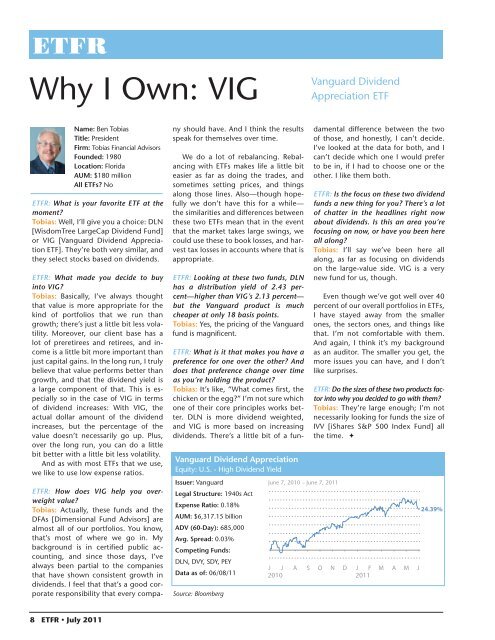US-Listed ETFs Sorted by Asset Class and Year-to-Date Return
US-Listed ETFs Sorted by Asset Class and Year-to-Date Return
US-Listed ETFs Sorted by Asset Class and Year-to-Date Return
You also want an ePaper? Increase the reach of your titles
YUMPU automatically turns print PDFs into web optimized ePapers that Google loves.
Why I Own: VIG<br />
Vanguard Dividend<br />
Appreciation ETF<br />
Name: Ben Tobias<br />
Title: President<br />
Firm: Tobias Financial Advisors<br />
Founded: 1980<br />
Location: Florida<br />
AUM: $180 million<br />
All <strong>ETFs</strong>? No<br />
ETFR: What is your favorite ETF at the<br />
moment?<br />
Tobias: Well, I’ll give you a choice: DLN<br />
[WisdomTree LargeCap Dividend Fund]<br />
or VIG [Vanguard Dividend Appreciation<br />
ETF]. They’re both very similar, <strong>and</strong><br />
they select s<strong>to</strong>cks based on dividends.<br />
ETFR: What made you decide <strong>to</strong> buy<br />
in<strong>to</strong> VIG?<br />
Tobias: Basically, I’ve always thought<br />
that value is more appropriate for the<br />
kind of portfolios that we run than<br />
growth; there’s just a little bit less volatility.<br />
Moreover, our client base has a<br />
lot of preretirees <strong>and</strong> retirees, <strong>and</strong> income<br />
is a little bit more important than<br />
just capital gains. In the long run, I truly<br />
believe that value performs better than<br />
growth, <strong>and</strong> that the dividend yield is<br />
a large component of that. This is especially<br />
so in the case of VIG in terms<br />
of dividend increases: With VIG, the<br />
actual dollar amount of the dividend<br />
increases, but the percentage of the<br />
value doesn’t necessarily go up. Plus,<br />
over the long run, you can do a little<br />
bit better with a little bit less volatility.<br />
And as with most <strong>ETFs</strong> that we use,<br />
we like <strong>to</strong> use low expense ratios.<br />
ETFR: How does VIG help you overweight<br />
value?<br />
Tobias: Actually, these funds <strong>and</strong> the<br />
DFAs [Dimensional Fund Advisors] are<br />
almost all of our portfolios. You know,<br />
that’s most of where we go in. My<br />
background is in certified public accounting,<br />
<strong>and</strong> since those days, I’ve<br />
always been partial <strong>to</strong> the companies<br />
that have shown consistent growth in<br />
dividends. I feel that that’s a good corporate<br />
responsibility that every company<br />
should have. And I think the results<br />
speak for themselves over time.<br />
We do a lot of rebalancing. Rebalancing<br />
with <strong>ETFs</strong> makes life a little bit<br />
easier as far as doing the trades, <strong>and</strong><br />
sometimes setting prices, <strong>and</strong> things<br />
along those lines. Also—though hopefully<br />
we don’t have this for a while—<br />
the similarities <strong>and</strong> differences between<br />
these two <strong>ETFs</strong> mean that in the event<br />
that the market takes large swings, we<br />
could use these <strong>to</strong> book losses, <strong>and</strong> harvest<br />
tax losses in accounts where that is<br />
appropriate.<br />
ETFR: Looking at these two funds, DLN<br />
has a distribution yield of 2.43 percent—higher<br />
than VIG’s 2.13 percent—<br />
but the Vanguard product is much<br />
cheaper at only 18 basis points.<br />
Tobias: Yes, the pricing of the Vanguard<br />
fund is magnificent.<br />
Vanguard Dividend Appreciation<br />
Equity: U.S. - High Dividend Yield<br />
Issuer: Vanguard<br />
Legal Structure: 1940s Act<br />
Expense Ratio: 0.18%<br />
AUM: $6,317.15 billion<br />
ADV (60-Day): 685,000<br />
Avg. Spread: 0.03%<br />
Competing Funds:<br />
DLN, DVY, SDY, PEY<br />
Data as of: 06/08/11<br />
Source: Bloomberg<br />
June 7, 2010 – June 7, 2011<br />
ETFR: What is it that makes you have a<br />
preference for one over the other? And<br />
does that preference change over time<br />
as you’re holding the product?<br />
Tobias: It’s like, “What comes first, the<br />
chicken or the egg?” I’m not sure which<br />
one of their core principles works better.<br />
DLN is more dividend weighted,<br />
<strong>and</strong> VIG is more based on increasing<br />
dividends. There’s a little bit of a fundamental<br />
difference between the two<br />
of those, <strong>and</strong> honestly, I can’t decide.<br />
I’ve looked at the data for both, <strong>and</strong> I<br />
can’t decide which one I would prefer<br />
<strong>to</strong> be in, if I had <strong>to</strong> choose one or the<br />
other. I like them both.<br />
ETFR: Is the focus on these two dividend<br />
funds a new thing for you? There’s a lot<br />
of chatter in the headlines right now<br />
about dividends. Is this an area you’re<br />
focusing on now, or have you been here<br />
all along?<br />
Tobias: I’ll say we’ve been here all<br />
along, as far as focusing on dividends<br />
on the large-value side. VIG is a very<br />
new fund for us, though.<br />
Even though we’ve got well over 40<br />
percent of our overall portfolios in <strong>ETFs</strong>,<br />
I have stayed away from the smaller<br />
ones, the sec<strong>to</strong>rs ones, <strong>and</strong> things like<br />
that. I’m not comfortable with them.<br />
And again, I think it’s my background<br />
as an audi<strong>to</strong>r. The smaller you get, the<br />
more issues you can have, <strong>and</strong> I don’t<br />
like surprises.<br />
ETFR: Do the sizes of these two products fac<strong>to</strong>r<br />
in<strong>to</strong> why you decided <strong>to</strong> go with them?<br />
Tobias: They’re large enough; I’m not<br />
necessarily looking for funds the size of<br />
IVV [iShares S&P 500 Index Fund] all<br />
the time. <br />
J J A S O N D J F M A M J<br />
2010<br />
2011<br />
24.39%<br />
8 ETFR • July 2011
















